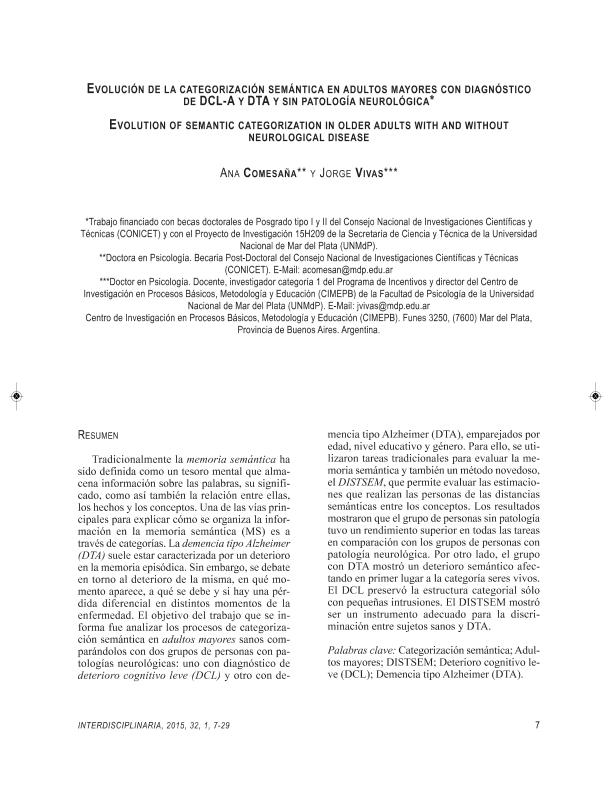Artículo
Tradicionalmente la memoria semántica ha sido definida como un tesoro mental que almacena información sobre las palabras, su significado, como así también la relación entre ellas, los hechos y los conceptos. Una de las vías principales para explicar cómo se organiza la información en la memoria semántica (MS) es a través de categorías. La demencia tipo Alzheimer (DTA) suele estar caracterizada por un deterioro en la memoria episódica. Sin embargo, se debate en torno al deterioro de la misma, en qué momento aparece, a qué se debe y si hay una pérdida diferencial en distintos momentos de la enfermedad. El objetivo del trabajo que se informa fue analizar los procesos de categorización semántica en adultos mayores sanos comparándolos con dos grupos de personas con patologías neurológicas; uno con diagnóstico de deterioro cognitivo leve (DCL) y otro con demencia tipo Alzheimer (DTA), emparejados por edad, nivel educativo y género. Para ello, se utilizaron tareas tradicionales para evaluar la memoria semántica y también un método novedoso, el DISTSEM, que permite evaluar las estimaciones que realizan las personas de las distancias semánticas entre los conceptos. Los resultados mostraron que el grupo de personas sin patología tuvo un rendimiento superior en todas las tareas en comparación con los grupos de personas con patología neurológica. Por otro lado, el grupo con DTA mostró un deterioro semántico afectando en primer lugar a la categoría seres vivos. El DCL preservó la estructura categorial sólo con pequeñas intrusiones. El DISTSEM mostró ser un instrumento adecuado para la discriminación entre sujetos sanos y DTA. Traditionally, semantic memory has been defined as a mental trove that contains organized information about words and their meaning, as well as relationships between words, facts and concepts.There are different ways of explaining how the information in such memory system is represented and organized. One of the main ways of explaining this organization is through categories. Categorization starts the very moment that any sensorial perception is associated to an abstract category; it is the ability to organize information in equivalence classes, and it is very important because it allows us to summarize the information that we gather through our senses and thus facilitate its manipulation. Alzheimer's disease (AD) is the main cause of dementia among older adults, and it is one of the most pressing sanitary, social and cultural problems of the present times. The main risk factor for the illness is age, for its prevalence augments exponentially from 65 to 85 years old, and due to the rise in life expectancy it is considered that it might be transformed into a world-wide epidemic in the coming years. The start of the illness is insidious and slowly progressing, and it is characterized by a loss of episodic memory from its beginnings. With respect to the deterioration of semantic memory in AD, a debate has arisen about its mode of presentation, its causes, and whether there is a differential loss of categories (live or non-live beings) in different moments of the illness. During the 90s, Petersen proposed the concept of mild cognitive impairment (MCI) to label the subjects with a functional cognitive impairment insufficient to diagnose a dementia syndrome. The importance of this syndrome is that between 8 to 15% of those who suffer it evolve to AD annually, while in the general population this evolution is only from 1 to 2%. However, there is a great controversy about the validity and scope of the term MCI, for its etiology can be very varied and it is very difficult to predict its evolution. There are different sub-kinds of MCI, and the amnesic form is the more likely to evolve into AD, for its main characteristic is the subjective deterioration of memory corroborated by standardized test by reference to normative data for the same age and educational level of the subject. The other cognitive functions not present alterations. The main objective of this work was to analyze the semantic categorization processes in healthy older adults comparing them with two groups of people with neurological pathologies, one with diagnosis of MCI and the other with AD, matched by age, educational level and gender. To evaluate this categorization process, two traditional tasks were used together with a novel method, the DISTSEM, which allows the evaluation of the estimation made by people about the semantic distance among a set of given concepts. The results showed that the group of people without pathologies had a superior performance in all the tasks in comparison with the groups of people with neurological pathologies. On the other hand, the group with AD showed a semantic impairment which affected in the first place the category of live beings, which was evident in the all the tasks. The MCI preserved the categorical structure with only minor intrusions. The DISTSEM has shown itself to be a valuable instrument that allows the discrimination between healthy subjects and those with AD. It is expected that this work can provide empirical evidence relevant to the debate surrounding semantic memory, for studies in patients with brain injury offer key information to examine the organizing models of such memory.
Evolución de la categorización semántica en adultos mayores con diagnóstico de DCL-A y DTA y sin patología neurológica
Título:
Evolution of semantic categorization in older adults with and without neurological disease
Fecha de publicación:
07/2015
Editorial:
Centro Interamericano de Investigaciones Psicológicas y Ciencias Afines
Revista:
Interdisciplinaria
ISSN:
0325-8203
e-ISSN:
1668-7027
Idioma:
Español
Tipo de recurso:
Artículo publicado
Clasificación temática:
Resumen
Palabras clave:
Categorización Semántica
,
Adultos Mayores
,
Distsem
,
Demencia Tipo Alzahiemer
Archivos asociados
Licencia
Identificadores
Colecciones
Articulos(CCT - MAR DEL PLATA)
Articulos de CTRO.CIENTIFICO TECNOL.CONICET - MAR DEL PLATA
Articulos de CTRO.CIENTIFICO TECNOL.CONICET - MAR DEL PLATA
Citación
Comesaña, Ana; Vivas, Jorge Ricardo; Evolución de la categorización semántica en adultos mayores con diagnóstico de DCL-A y DTA y sin patología neurológica; Centro Interamericano de Investigaciones Psicológicas y Ciencias Afines; Interdisciplinaria; 32; 1; 7-2015; 7-29
Compartir
Altmétricas




